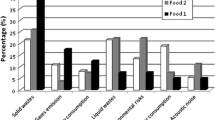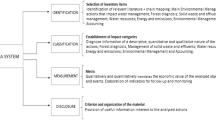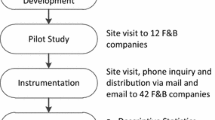Abstract
This paper attempts to assess environmental performance indicators (EPIs) of Tunisian food industry as well as the effectiveness of its environmental management system (EMS) according to the ISO 14001 standard. It is related to the management effort which is measured by management performance indicators and to organization’s operations representing the operational performance indicators in order to reduce the significance of environmental impacts. Otherwise, it does reflect critical success and barriers of environmental performance of a food company for its management and operation processes according to the Tunisian context. Moreover, this research focuses on environmental condition indicators (ECIs) in developing of environmental performance evaluation (EPE). EPIs and ECIs depend closely on the compliance of the food company with applicable laws and regulatory requirements that stimulate the pollution prevention. Furthermore, EPE integrates environmental and human health risks in assessment process consequently ensuring the adoption of a new policy by decision makers under the concept of continuous improvement. However, it should discuss a voluntary initiative taking by the top managers to prevent pollution and to share information in a structured and regular way.

Similar content being viewed by others
References
Alshuwaikhat HM, Abubaka I (2008) An integrated approach to achieving campus sustainability: assessment of the current campus environmental management practices. J Clean Prod 16:1777–1785
Anton WRQ, Deltas G, Khannac M (2004) Incentives for environmental self-regulation and implications for environmental performance. J Environ Econ Manage 48:632–654
Arimura TH, Hibiki A, Katayama H (2008) Is a voluntary approach an effective environmental policy instrument? Acase for environmental management systems. J Environ Econ Manage 55:281–295
Bansal P, Roth K (2000) Why companies go green: a model of ecological responsiveness. Acad Manag J 43(4):717–736
Barney JB (1986) Strategic factor markets: expectations, luck, and business strategy. Manag Sci 32:1231–1241
Campos LMS, Heizen DAD, Verdinelli MA, Miguel PAC (2015) Environmental performance indicators: a study on ISO 14001 certified companies. J Clean Prod 99:286–296
Curkovic S, Sroufe R (2010) Using ISO14001 to promote a sustainable supply chain strategy. Bus Strateg Environ. doi:10.1002/bse.671
Daddi T, Magistrelli M, Frey M, Iraldo F (2011) Do environmental management systems improve environmental performance? Empirical evidence from Italian companies. Environ Dev Sustain 13:845–862
Daddi T, Frey M, De Giacomo MR, Testa F (2015) Macro-economic and development indexes and ISO 14001 certificates: a cross national analysis. J Clean Prod 108:1239–1248
Darnall N, Edwards DJ (2006) Predicting the cost of environmental management system adoption: the role of capabilities, resources, and ownership structure. Strateg Manag J 27(4):301–320
Davis SJ, Caldeira K, Matthews HD (2010) Future CO2 emissions and climate change from existing energy infrastructure. Sci Mag 329:1330–1333
G4 Sector Disclosures (2014) Food processing. https://www.globalreporting.org/resourcelibrary/ GRI-G4-Food-Processing-Sector-Disclosures.pdf
Global metrics for the environment, EPI report (2016). http://epi.yale.edu/sites/default/files/2016EPI_Full_Report_opt.pdf
Gordon F, Jonathan NH, Philip AA (2010) Effectiveness of planning and implementation stages of the ISO14001 standards EMS at Obuasi gold mine. Am J soc Manag Sci, Ghana. doi:10.5251/ajsms.2010.1.1.1.12
Granly B, Welo T (2014) EMS and sustainability: experiences with ISO 14001 and Eco-Lighthouse in Norwegian metal processing SMEs. J Clean Prod 64:194–204
Hall R (1992) The strategic analysis of intangible resources. Strateg Manag J 13:135–144
Hřebiček J, Faldik O, Edward Kasem E, Trenz O (2015a) Determinants of sustainability reporting in food and agriculture sectors. Acta Univ Agric Silvic Mendelianae Brun 63(2):539–552. doi:10.11118/actaun201563020539
Hřebiček J, Soukopová J, Trenz O (2015b) Current trends of economic modelling of sustainable corporate performance and reporting—review and research agenda. Procedia Eco Finan 12:234–242
Inman RA (2002) Implications of environmental management for operations management. Prod Plan Control Manag Oper 13(1):47–55
ISO 14001 (2015) Environmental management system—specification with guidance for use. International organization for standardization
ISO 14031 (2013) Environmental management—environmental performance evaluation guidelines
ISO 14040 (2006) Environmental management—Life cycle assessment—Principles and framework.
Johansson TB, Williams RH, Ishitani H, Edmonds JA (1996) Options for reducing CO2 emissions from the energy supply sector. Energy Policy 24:985–1003
Kaur H (2011) Impact of human resource factors on perceived environmental performance: an empirical analysis of a sample of ISO 14001 EMS companies in Malaysia. J Sustain Dev 4(1):211–224
Kwon DM, Min-Seak S, Yong-Chil S (2002) A study of compliance with environmental regulations of ISO 14001 certified companies in Korea. J Environ Manag 65:347–353
McGuire W (2014) The effect of ISO 14001 regulatory compliance in China. Ecol Econ 105:254–264
Mohammed M (2000) The ISO 14001 EMS implementation process and its implications: a case study of central Japan. J Environ Manag 25:177–188
Nguyen QA, Hens L (2015) Environmental performance of the cement industry in Vietnam: the influence of ISO 14001 certification. J Clean Prod 96:362–378
Nilsson L, Persson PO, Rydén L, Darozhka S, Zaliauskiene A (2007) Cleaner production: technologies and tools for resource efficient production. In: Tryckeri N (ed) Book 2 in a series on Environmental Management. The Baltic University Press, Uppsala, Sweden
NT 106.02 (1989) Protection de l’environnement-Rejets d’effluents dans le milieu hydrique, National Institute of Normalization and Industrial propriety, INNORPI
NT 106.16 (2000) Management environemental—Evaluation de la performance environmentale—Lignes directrices, National Institute of Normalization and Industrial propriety, INNORPI
NT 106.09 (2005) Systeme de management environemental—Lignes directrices generales concernant les principes, les systemes et les techniques de mise en oeuvre, National Institute of Normalization and Industrial propriety, INNORPI
NT 48.289-8 (2010) Protecteurs individuels contre le bruit—Exigences de sécurité et essais—Partie 8: Serre-tête audio de divertissement, National Institute of Normalization and Industrial property, INNORPI
Phan TN, Baird K (2015) The comprehensiveness of environmental management systems: the institutional pressures and the impact on environmental performance. J Environ Manag 160(2015):45–56
Pires A, Martinho G, Chang NB (2011) Solid waste management in European countries: a review of systems analysis techniques. J Environ Manag 92:1033–1050
Seiffert MEB (2008) Environmental impact evaluation using a cooperative model for implementing EMS (ISO 14001) in small and medium-sized enterprises. J Clean Prod 16:1447–1461
Sharma S, Henriques I (2005) Stakeholder influences on sustainability practices in the Canadian forest products industry. Strateg Manag J 26:159–180
Singh M, Brueckner M, Padhy PK (2014) Insights into the state of ISO14001 certification in both small and medium enterprises and industry best companies in India: the case of Delhi and Noida. J Clean Prod 69:225–236
Sustainability Assessment of Food and Agriculture systems, SAFA (2014) http://www.fao.org/fileadmin/templates/nr/sustainability_pathways/docs/SAFA_Indicators_Version_3.0.pdf
Teece DJ (1980) Contributions and impediments of economic analysis to the study of strategic management. In: Frederisckson JW (ed) Perspectives on strategic management. Harp Bus, New York, pp 39–80
Telle K, Larsson J (2007) Do environmental regulations hamper productivity growth? How accounting for improvements of plants’ environmental performance can change the conclusion. Ecol Econ 61:438–445
Testa F, Styles D, Iraldo F (2012) Case study evidence that direct regulation remains the main driver of industrial pollution avoidance and may benefit operational efficiency. J Clean Prod 21:1–10
Testa F, Rizzi F, Daddi T, Gusmerotti NM, Frey M, Iraldo F (2014) EMAS and ISO 14001: the differences in effectively improving environmental performance. J Clean Prod 68:165–173
The European Eco-management and Audit Scheme, EMAS (2014). http://ec.europa.eu/environment/emas/index_en.htm
To WM, Tang MNF (2014) The adoption of ISO 14001 environmental management systems in Macao SAR, China: trend, motivations, and perceived benefits. Manag Environ Qual Int J 25(2):244–256
Toffel MW, Marshall JD (2004) Improving environmental performance assessment: comparative analysis of weighting methods used to evaluate chemical release inventories. J Ind Ecol 8(1–2):143–172
Tollefsen P, Rypdal K, Torvanger A, Rive N (2009) Air pollution policies in Europe: efficiency gains from integrating climate effects with damage costs to health and crops. Environ Sci Policy 12:870–881
Topuz E, Talinli I, Aydin E (2011) Integration of environmental and human health risk assessment for industries using hazardous materials: a quantitative multi criteria approach for environmental decision makers. Environ Int 37:393–403
Turki M, Medhioub E, Kallel M (2015) Effectiveness of EMS in Tunisian companies: framework and implementation process based on ISO 14001 standard. Environ Dev Sustain. doi:10.1007/s10668-015-9741-z
UNEP/DEPA (2000) United Nations environment programme/Danish environmental protection agency. Cleaner Production Assessment in Dairy Processing, Industrial Sector Guides
Viegas M (2005) Environmental performance evaluation—ISO4031:1999 and the Future. Plenary lecture at the ISO Technical Committee 207 Madrid, 14 Sept 2005
Zhang W, Wang W, Wang S (2014) Environmental performance evaluation of implementing EMS (ISO 14001) in the coating industry: case study of a shanghai coating firm. J Clean Prod 64:205–217
Acknowledgements
The authors acknowledge the support of food enterprise in Tunisia to their collaboration about this study.
Author information
Authors and Affiliations
Corresponding author
Rights and permissions
About this article
Cite this article
Turki, M., Medhioub, E. & Kallel, M. Evaluation of a national food industry based on environmental performance and condition indicators: critical success and barriers of EMS implementation in Tunisia. Environ Syst Decis 37, 423–434 (2017). https://doi.org/10.1007/s10669-017-9646-5
Published:
Issue Date:
DOI: https://doi.org/10.1007/s10669-017-9646-5




